|
TennisOne Lessons


Ball Speed Versus Depth
Ray and Becky Brown
In relation to winning tennis, the question is often asked, "What is more important, speed or depth?" Conventional wisdom sides with depth, but has never explained why. In this article we examine speed versus depth scientifically to see who is right. Following this, we comment briefly on the intelligent use of speed.
Today, there is a fascination with ball speed. For example, we just returned from measuring (with doppler radar) players in practice and competition at the Advanta WTA event in Philadelphia. What we saw there was that the women are exploring the limits of ground stroke speed. It was common to see rallies in which ball speeds were over 70mph with some achieving ball speeds of 80 mph.
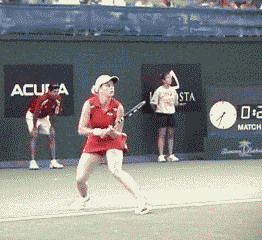 In women's tennis, it is not uncommon to see rallies in which ball speeds are over 70mph with some achieving ball speeds of 80 mph.
In women's tennis, it is not uncommon to see rallies in which ball speeds are over 70mph with some achieving ball speeds of 80 mph. |
To put this in perspective, we have found female NTRP 4.5 rally speeds to be around 48-50 mph with occasional speeds reaching 57 mph. College level women can sustain short rallies of over 60 mph and can reach speeds of 70 mph. Men's speeds run about 5mph higher than women's speeds.
As another way of getting a sense of what this speed means, if you are rallying cross court, and your opponent surprises you by hitting a 70mph ground stroke down the line to the baseline, even an olympic sprinter will not have sufficient speed to reach the ball in time to strike it. In short, ground strokes of 70mph and over are very fast.
While the initial speed of the ball is being vigorously explored by many players, some players have taken a different approach. While at the Van der Meer Academy last month, Becky had the opportunity to work out with Jolene Watanabe (formerly ranked 71 on the WTA charts).
Jolene had no interest in hitting the ball with high initial speeds. Rather she concentrated on hitting the ball with moderate speed (60-63mph) to the baseline. To Becky's surprise, Jolene was much harder to rally with than her regular partner, Andreea Fusea, who hit the ball much faster. The answer lay in looking at the average ball speed over the length of the court, rather than the initial (radar measured) ball speed.
To understand this phenomena, we conducted a detailed analysis of of the flight of the ball and its average velocity. To summarize the results, we found that the longer the ball travels through the air, the higher its average velocity when compared to a ball that hits the court and bounces. The problem is that the bounce takes a lot of velocity out of the forward motion of the ball. Hence a deeper ball, hit more slowly, is just as good as a faster ball that falls short. Since a slower ball hit deep is less likely to result in an unforced error, the rally can go on and on until some drops from exhaustion.
Let us point out that slowing down the rally is not the same as a moon ball rally. The deep ball has a good initial velocity unlike a moon ball, and does not go anywhere nearly as high. The average velocity of a moon ball is quite a bit slower. This explained why Jolene's ball was so much harder to play against than Andreea's. Our analysis is in the table below. The reader who is not interested in the scientific details may skip to the next section, Using Speed Intelligently.
 |
In the formula to the left, t is time, s is distance the ball travels and v0 is the initial velocity of the ball. |
|
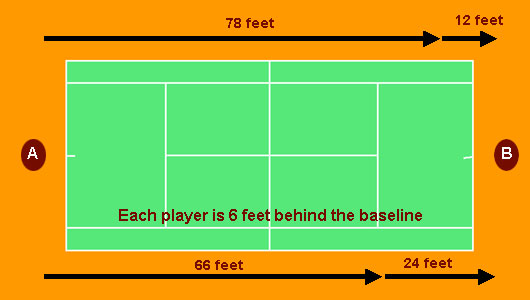 |
The analysis:
Our analysis constraints are illustrated in the figure above. In that figure the ovals represent the two players standing 6 feet behind the baseline. We assume that the player on the left, player A, will strike the ball so that its initial velocity (the velocity measured by radar) is 60mph.
Case 1 We assume that the ball bounces at the service line and looses 40% of its velocity from the bounce. This is a reasonable figure for the loss of ball speed due to the bounce when the ball crosses low over the net. Since we will apply this assumption to both cases, it is not very important. Using formulae from physics we know that if the initial velocity is 60mph, then after 66 feet the velocity is about 40mph. Using our formula above, we know that the time it takes the ball to travel this distance is 0.92 seconds. After the bounce, the velocity is only 24mph due to the effect of the court surface on the forward direction of the ball. The ball must travel an additional 24 feet at a greatly reduced speed to reach player B on the right. We will assume for the purposes of illustration that player B does not move forward to take advantage of the short ball which only improves their situation. Hence we are explaining the best case for player A. Starting at 24mph after the bounce, we use our the formulae from physics again to conclude that the ball velocity when the ball reaches player B is about 21mph. The time of transit is 0.73 seconds. Thus the total time for the ball to reach player B after player has struck the ball at 60mph is 0.92+0.73 = 1.65 seconds.
Case 2 In this case the ball has traveled through the air 78 feet before the bounce .Starting at 60mph the ball is traveling at 37.6mph just before the bounce and therefore about 22.6mph after the bounce. The time of transit over 78 feet is 1.13 seconds. It must go an addition 12feet to reach player B. It takes about 0.376 seconds for the ball to cross this distance. Total time of transit is therefore 1.13 + 0.376 = 1.5 seconds.
Conclusion The difference in time of transit is 0.15 seconds. The reaction time of an average human can be as much as 0.4 seconds. Even very fast reaction times for doing simple tasks such as pressing a button can be as long as 0.15seconds. When reaction time plus preparation time are both considered, the ball that bounced within 6 feet of the baseline creates a very significant advantage for player A. |
The moral of this story is clear, depth is more significant that speed because the longer the ball travels through the air, the faster it will reach your opponent. Hence a slower ball that is deep can be superior to a fast ball that falls short. Over several shots, this difference in speed accumulates to create a significant advantage for the player who hits the ball deep.
Using Speed Intelligently
The above analysis of speed versus depth raises the question of what is the right use of high initial ball speed. We know for a fact that a safe baseline rally speed is about 60mph. Professor Howard Brody has conducted extensive research to establish this figure. Further, we have noted at the Advanta and other tournaments, that when a match gets tight, intelligent, disciplined, and experienced players revert back to 60 mph rallies. Since this is the intelligent thing to do, we ask: How are they able to do this?
A more general question is how are the top players able to select the right speed for the right situation consistently? The answer is that they have come to know (internally sense) every component of motion that affects ball speed and have developed a sense of what combination of these components must be used in any given situation. In order to accelerate the process of learning to use speed intelligently, we have recently conducted an analysis of the six components of body motion that contribute to ball speed.
From our analysis we found that a human can theoretically hit a ground stroke over 110 mph. Using state-of-the-art doppler radar, we have measured college players who were able to hit their forehand at 100mph and keep it in the court, hence the figure of 110mph seems reasonable. Our analysis looked at six components of motion that can contribute to ball speed. They are: (1) the legs; (2) the hips; (3) upper arm rotation; (4) the shoulder punch; (5) shoulder rotation; (6) the wrist snap( not to be used by beginners). We discuss each in turn below.
The Legs: The leg component is that component that is produced by stepping (lunging) into the ball. Measuring a very rapid lunge shows that this may produce as much as 7 mph forward body movement although 3 mph is more typical. The forward body speed may be translated directly into racquet speed. Using Professor Brody's calculations we may translate this into ball speed by multiplying the racquet speed by 1.5. As a result, we find that the lunge can produce between 4.5 and 10.5 mph of ball speed. In isolation, this may sound insignificant, but if your standing racquet speed is 50 mph (the racquet speed you produce by just dropping a ball and striking it), then the lunge can increase your ball speed to 60 mph. This is very significant.
The Hips: The hip turn is produced by the legs forcing the hips to rotate. The hips have no muscles of their own. This measurement was a surprise. We found that the hip rotation could produce 10 mph of rotational speed. If we can translate this into racquet speed, this produces 15mph of ball speed.
The Upper Arm Rotation: This motion is produced by rotating the upper arm as in the acceleration stage of a stroke (see forehand article). We observed a wide range of variation in this component from 12 to 18 mph. Taking the conservative figure of 12 mph this gives 18 mph of ball speed.
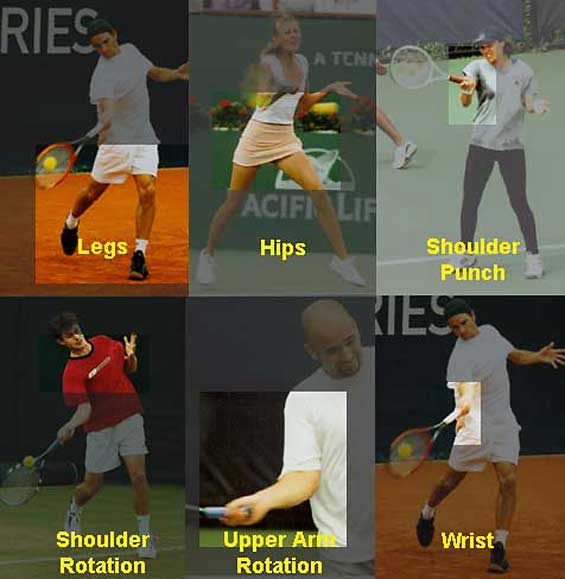
Copyright notice: The rights for commercial use of the photos above have been obtained from the originator of the photos: Sportfiles. Original clear 4X6 copies of these photos can be obtained at http://sportfiles.com/ for $2.00 each. |
The Shoulder Punch: This component is produced as seen at the illustrations in our last article. The shoulder component was found to have a range of 7 to 12 mph. This translates into a ball speed of 10.5 to 18 mph.
The Shoulder Rotation: This is the component obtained by rotating the shoulders. The shoulder rotation produced 17 mph of racquet speed giving 26 mph of ball speed.
The Wrist. This the most unexpected component. It is produced by a wrist movement which advances the racquet forward to the ball. It was measured to be approximately 10 mph, providing a ball speed of 15 mph. By-the-way, this is a movement that is easily misused. 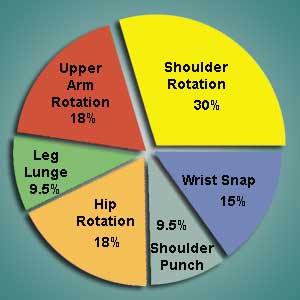
If one were to link these movements together in a manner that summed the speeds from the individual components, one could obtain racquet speeds of 60 mph or better and ball speeds of 90 mph or better. These are ball speeds from the racquet head speed alone (this does not count the speed of the incoming ball). Using the most favorable measurements, this suggests that ball speeds of over 110 mph are possible from ground strokes.
These are theoretical speeds. As noted above, we have measured speeds on our radar of 100 mph from college players. However, as noted above, if you rally at a speed above about 60 mph, the probability of an error is very great.
We summarize this data, simplifying it to take into consideration statistical errors, in the Pie Chart which shows, in gross terms, the percentage contribution to ball speed from each of the six components.
Choosing the right combination of components
From our analysis so far, it is clear that creating a training regime for selecting the right combination of stroke ingredients for a given situation is a science in its infancy. For example, each component of motion can be isolated and developed to perfection for maximum value. Also, developing the skills for integrating these components can be determined scientifically. Doing this will cut years off the development of a professional player's skills.
The next step is to classify ground stroke situations into a few groups for which a complete analysis can be made. Among other factors will be the determination of the optimal speed to strike a ball in each class. A full description of the right combinations to practice for each situation would require a very long article. Hence we confine ourselves to a few examples: (1) If the player is nervous about approaching the net, then the shoulder and hip rotation components should be reduced, the leg lunge made moderate, the wrist snap eliminated, upper arm rotation reduced to a minimum and the shoulder punch exaggerated. If the player has developed each of these components separately, this will be easy to accomplish. (2) As another example, if the player is returning a low fast ball and is feeling confident, they may elect to use the wrist snap, in combination with other components, in place of lifting the ball. This will result a much faster return.
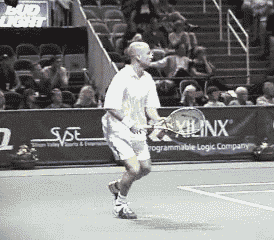 Skilled pros like Andre Agassi may produce ball speeds over eighty MPH during a rally, but depth may be more important.
Skilled pros like Andre Agassi may produce ball speeds over eighty MPH during a rally, but depth may be more important. |
However, we caution one must understand the theory of the wrist snap to do this successfully. (3) If one is faced with a player who pushes the ball back so that the ball bounces 6-7 feet at its maximum (thus clears the net by about 11 feet), the shoulder punch, in combination with other elements will slam the ball back down with sufficient force stop this strategy.
It is important to note that not every pro uses all of the six components. Some just favor a certain subset and never expand out to the full set. Also, some components are more suitable for certain grips. For example, the far western grip is less suitable for the shoulder punch than for the shoulder rotation. Also, some body types favor certain components. The shoulder punch is easier for a western grip player with broad shoulders. The reader should experiment to see which components best suit them and which components they can develop that they do not presently use.
Summary
Speed is fascinating and players are always testing the speed barrier to see how far it can be pushed. However, it is the average speed that really matters, and it is the right speed at the right time that is most important. We have explained how the average speed can be deceptive and how to produce speed using the various components of body motion. By approaching tennis scientifically, we are in a position to advance the sport rapidly and to improve the skills of the recreational player to a level that the sport of tennis will regain its popularity of the 1970's.
Your comments are welcome. Let us know what you think about Ray and Becky Brown's article by emailing us here at TennisONE.

Ray and Becky Brown are the founders of EASI TennisTM. The EASI TennisTM System is a new and revolutionary method of teaching stroke technique that can dramatically reduce the time needed to learn to play master, or any level, of tennis. To learn more about the EASI TennisTM System, click here.

 Ray Brown, Ph.D. Ray Brown, Ph.D.
Over the past ten years Ray Brown has been working in the area of neuroscience and brain dynamics. During this time, he has conducted extensive experiments in conjunction with his wife to determine whether neuroscience can be applied to dramatically accelerate tennis training. Dr. Brown received his Ph.D. in mathematics from the University of California, Berkeley in the area of nonlinear dynamics and has over 30 years of experience in the analysis of nonlinear systems. He has published over 20 articles on tennis coaching and player development and over 35 scientific papers on complexity, chaos, and nonlinear processes.
 Becky Brown, M.S. Becky Brown, M.S.
Using the new training methods developed in research with her husband, Becky Brown went from a USTA NTRP tennis rating of 3.5 to a professional world ranking of 1,069 in less than four years. Prior to the inception of this neuroscience research, Becky Brown had no previous high school, college or professional experience in tennis. Ms Brown received her M.S. in applied mathematics from Johns Hopkins University and has over eighteen years experience in the development of high technology defense systems. With her husband she has co-authored numerous articles on tennis training and coaching.
|
|







 Ray Brown, Ph.D.
Ray Brown, Ph.D.